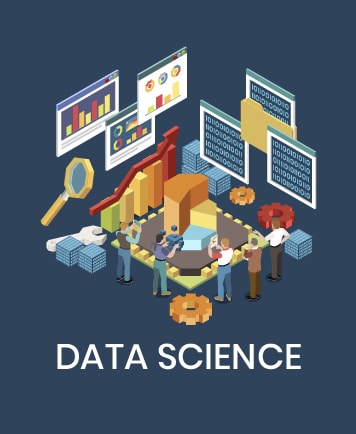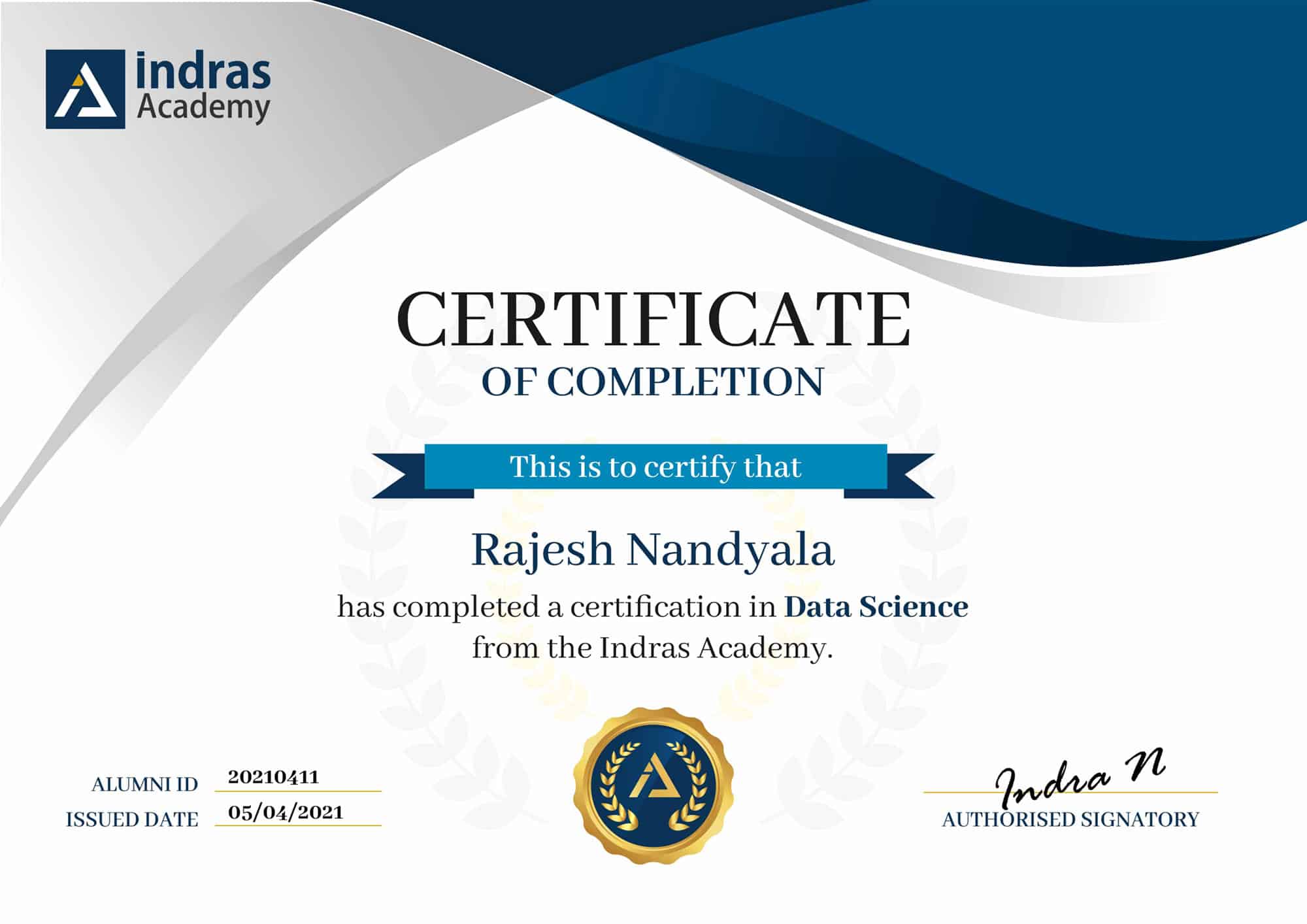Job Oriented Salesforce Courses in Bangalore
Looking for best salesforce training institute in Bangalore? You’re in the right place. Here at Indras Academy, we are committed to empower you with our world-class data science curriculum, industry-leading faculty and real life project experience. Enroll today and get 40% off. Limited Period Offer!!
- 100% Placement Support
- Project-Based Learning
- Updated Course Curriculum
- Trainers from Industry Expert
Request a Course Details

Salesforce Course Overview
We are one of the leading online and classroom data science training institute in Bangalore, India. Our curriculum is designed by industry experts to help you master data science in Python, R, Machine Learning Statistics, Tableau, and more. We have helped people from all backgrounds get their dream jobs and secure placement in the industry.
- No prior Experience or Knowledge Required
- 100% Quality Training Guarantee
- 100% job assistance
- Lowest fees with easy EMI instalments
- Structured guidance by experts
- 12 Lakh Average annual salary
- Give Your Career a Boost
Why Choose Indrasacademy for Salesforce Training?
Indra’s Academy’s Data Science course is to prepare candidates to use Data Science techniques for business opportunities. Our highly skilled Data Science trainers possess corporate experience and understand what real job demands. Hence, we offer hands-on training with live projects.
- 100% job assistance
- Certified trainers
- 1000+ Career Transitions
- Online as well as offline classes
- Learn from Industry Experts.
- Resume Building Sessions
Course Options
Live Virtual
Instructor Led Live Online
₹49,999 ₹35,499
- Profile Building Support
- Interview Preparation Support
- Course Completion Certifcate
- Live Industry Projects
- Complete Job Assistance

Classroom
In - Person Classroom Training
₹49,999 ₹39,950
- Profile Building Support
- Interview Preparation Support
- Course Completion Certifcate
- AssignmentsLive Industry Projects
- Complete Job Assistance
Data Science Training Curriculum
Are you looking for data science training in Bangalore? Look no further than our institute! We offer the best data science training in the city, with experienced faculty and state-of-the-art facilities. Join us today and start your journey to becoming a data science expert!
Programming Basics & Environment Setup
- Installing Anaconda
- Anaconda Basics and Introduction
- Get familiar with version control, Git and GitHub.
- Basic Github Commands.
- Introduction to the Jupyter Notebook environment.
- Basics Jupyter notebook Commands.
- Programming language basics.
- Python Overview
- Python 2.7 vs Python 3
- Writing your First Python Program Lines and Indentation
- Python Identifiers
- Various Operators and Operators Precedence
- Getting input from User, Comments, Multi line Comments.
- Working with Numbers, Booleans and Strings
- String types and formatting
- String operations Simple if Statement, if-else Statement if-elif Statement.
- Introduction to while Loops.
- Introduction to for Loops
- Using continue and break.
- Class hands-on: programs/coding exercise on string, loop and conditions in the classroom.
- List, Tuples, Dictionaries Python Lists, Tuples, Dictionaries
- Accessing Values, Basic Operations Indexing, Slicing, and Matrixes Built-in Functions & Methods.
- Exercises on List, Tuples And Dictionary
- Class hands-on: Program to convert tuple to dictionary Remove Duplicate from Lists
- Python program to reverse a tuple Program to add all elements in list.
- Introduction To Functions
- Why Defining Functions
- Calling Functions
- Functions With Multiple Arguments.
- Anonymous Functions
- Lambda Using Built-In Modules
- User-Defined Modules
- Module Namespaces
- Iterators And Generators.
- Opening and Closing Files
- open Function, file Object Attributes close() Method ,Read, write,seek.
- Exception Handling, try-finally Clause Raising an Exceptions, User-Defined Exceptions.
- Regular Expression- Search and Replace Regular Expression Modifiers Regular Expression Patterns.
- Introduction to Numpy.
- Array Creation,Printing Arrays
- Basic Operation -Indexing, Slicing and Iterating
- Shape Manipulation - Changing shape,stacking and splitting of arrays.
- Vector stacking, Broadcasting with Numpy, Numpy for Statistical Operation.
- Pandas : Introduction to Pandas Importing data into Python
- Pandas Data Frames, Indexing Data Frames
- ,Basic Operations With Data frame,Renaming Columns,Subletting and filtering a data frame.
- Introduction,plot(),Controlling Line
- Properties,Subplot with Functional Method, MUltiple Plot, Working with Multiple Figures,Histograms Seaborn :
- Intro to Seaborn And Visualizing statistical relationships
- Import and Prepare data
- Plotting with categorical data and Visualizing linear relationships
- Seaborn Exercise
Installation Setup
Quick guide to RStudio
User Interface RStudio's GUI3
Changing the appearance in RStudio
Installing packages in R and using the library
Development Environment
Overview Introduction to R
basics Building blocks of R
Core programming principles Fundamentals of R
Creating an object Data types in R
Coercion rules in R
Functions and arguments Matrices Data Frame
Data Inputs and Outputs with R
Vectors and Vector operation
Advanced Visualization Using the script vs. using the console
Data transformation with R - the Dplyr package - Part
Data transformation with R - the Dplyr package - Part Sampling data with the Dplyr package
Using the pipe operator in R Tidying data in R - gather() and separate()
Tidying data in R - unite() and spread()
Intro to data visualization
Introduction to ggplot2
Building a histogram with ggplot2
Building a bar chart with ggplot2
Building a box and whiskers plot with ggplot2
Building a scatter plot with ggplot2
Connecting To Datasource Creating dashboard pages
How to create calculated columns Different charts
Hands on on connecting data source and data cleansing
Hands on various charts
Getting Started With Visual Analytics Sorting and grouping
Working with sets
set action Filters: Ways to filter, Interactive Filters Forecasting andClustering
Hands on deployment of Predictive model invisualization
Working in Views with Dashboards and Stories
Working with Sheets Fitting Sheets
Legends and Quick Filters Tiled and Floating Layout Floating Objects
Coordinate points
Plotting Latitude and Longitude
Custom Geocoding
Polygon Maps
WMS and Background Image
Introduction to Text Analytics
Introduction to NLP
What is Natural Language Processing?
What Can Developers Use NLP Algorithms For?
NLP Libraries
Need of Textual Analytics Applications of Natural Language Processing
Word Frequency Algorithms for NLP Sentiment Analysis
Need of Pre-Processing
Various methods to Process the Text data
Tokenization, Challenges in Tokenization
Stopping, Stop Word Removal Stemming - Errors in Stemming Types of Stemming Algorithms - Table lookup Approach ,N-Gram Stemmers
String Similarity
Cosine Similarity
Mechanism - Similarity between Two text documents Levenshtein distance - measuring the difference between two sequences Applications of Levenshtein distance LCS(Longest Common Sequence )
Problems and solutions ,LCS Algorithms
Information Retrieval - Precision, Recall, F- score TF-IDF
KNN for document retrieval K-Means for document retrieval Clustering for document retrieval
Fundamentals of Math and Probability
- Basic understanding of linear algebra, Matrics, vectors.
- Addition and Multiplication of matrices.
- Fundamentals of Probability
- Probability distributed function and cumulative distribution function.
- Class Hand-on Problem solving using R for vector manipulation.
- Problem solving for probability assignments.
The mean,median,mode, curtosis and skewness Computing Standard deviation and Variance.
Types of distribution.
Class Handson: 5 Point summary BoxPlot Histogram and Bar Chart Exploratory analytics R Methods.
What is inferential statistics Different types of Sampling techniques Central Limit Theorem.
Point estimate and Interval estimate.
Creating confidence interval for population parameter Characteristics of Z-distribution and T- Distribution.
Basics of Hypothesis Testing Type of test and rejection region Type of errors in Hypothesis resting.
Type-l error and Type-ii errors P-Value and Z-Score Method T-Test, Analysis of variance(ANOVA) and Analysis of Covariance(ANCOVA) Regression analysis in ANOVA.
Class Hands-on: Problem solving for C.L.T Problem solving Hypothesis Testing Problem solving for T-test, Z-score test Case study and model run for ANOVA.
Basics of Hypothesis Testing Type of test and Rejection Region
Type o errors-Type 1 Errors,Type 2 Errors
P value method,Z score Method.
The Chi-Square Test of Independence Regression
Factorial Analysis of Variance
Pearson Correlation Coefficients in Depth Statistical Significance, Effect Size, and Confidence Intervals
Introduction to Data Cleaning
Data Preprocessing What is Data Wrangling?
How to Restructure the data? What is Data Integration?
Data Transformation
EDA : Finding and Dealing with Missing Values.
What are Outliers? Using Z- scores to Find Outliers.
Introduction to Bivariate Analysis,Scatter Plots and Heatmaps.
Introduction to Multivariate Analysis
Introduction To Machine Learning
What is Machine Learning?
Introduction to Supervised and Unsupervised Learning
Introduction to SKLEARN (Classification, Regression, Clustering, Dimensionality reduction, Model selection, Preprocessing)
What is Reinforcement Learning?
Machine Learning applications
Difference between Machine Learning and Deep Learning
Support Vector Machines Linear regression
Logistic Regression Naive Bayes
Linear discriminant analysis Decision tree
k-nearest neighbor algorithm Neural Networks (Multilayer perceptron)
Similarity learning
Introduction to Linear Regression
Linear Regression with Multiple Variables
Disadvantage of Linear Models
Interpretation of Model Outputs
Understanding Covariance and Collinearity
Understanding Heteroscedasticity
Case Study – Application of Linear Regression for Housing Price Prediction
Introduction to Logistic Regression.
Why Logistic Regression .
Introduce the notion of classification
Cost function for logistic regression
Application of logistic regression to multi-class classification.
Confusion Matrix, Odds Ratio And ROC Curve
Advantages And Disadvantages of Logistic Regression.
Case Study:To classify an email as spam or not spam using logisticRegression.
Decision Tree – data set How to build a decision tree?
Understanding Kart Model
Classification Rules- Overfitting Problem
Stopping Criteria And Pruning
How to Find the final size of Trees?
Model A Decision Tree.
Naive Bayes
Random Forests and Support Vector Machines
Interpretation of Model Outputs
Hierarchical Clustering
k-Means algorithm for clustering – groupings of unlabeled data points.
Principal Component Analysis(PCA)- Data
Independent components analysis(ICA) Anomaly Detection
Recommender System-collaborative filtering algorithm
Case Study– Recommendation Engine for e-commerce/retail chain
Basics of Time Series Analysis and Forecasting ,Method Selection in Forecasting
Moving Average (MA) Forecast Example,Different Components of Time Series Data ,Log Based Differencing, Linear Regression For Detrending
Introduction to ARIMA Models,ARIMA Model Calculations,Manual ARIMA Parameter Selection,ARIMA with Explanatory Variables
Understanding Multivariate Time Series and Their Structure,Checking for Stationarity and Differencing the MTS
Case Study : Performing Time Series Analysis on Stock Prices
Introduction to Deep Learning And TensorFlow
Neural Network
Understanding Neural Network
Model Installing
TensorFlow Simple Computation ,Constants And Variables
Types of file formats in TensorFlow
Creating A Graph – Graph Visualization
Creating a Model – Logistic Regression
Model Building using tensor flow
TensorFlow Classification Examples
Installing TensorFlow
Simple Computation , Contants And Variables
Types of file formats in TensorFlow
Creating A Graph - Graph Visualization
Creating a Model - Logistic Regression
Model Building
TensorFlow Classification Examples
Basic Neural Network Single Hidden Layer Model
Multiple Hidden Layer Model
Backpropagation – Learning Algorithm and visual representation
Understand Backpropagation – Using Neural
Network Example TensorBoard
Project on backpropagation
Convolutional Layer Motivation
Convolutional Layer Application
Architecture of a CNNPooling Layer Application
Deep CNN
Understanding and Visualizing a CNN
Introduction To RDBMS Single Table Queries - SELECT,WHERE,ORDER
BY,Distinct,And ,OR Multiple Table Queries: INNER, SELF, CROSS, and OUTER, Join, Left Join, Right Join, Full Join, Union.
Advance SQL Operations: Data Aggregations and summarizing the data
Ranking Functions: Top-N Analysis Advanced SQL Queries for Analytics.
Topics - What is HBase? HBase Architecture, HBase Components,
Storage Model of HBase, HBase vsRDBMS
Introduction to MongoDB, CRUD Advantages of MongoDB over RDBMS
Use cases
Mathematical Functions
Variables
Conditional Logic Loops
Custom Functions Grouping and Ordering Partitioning
Filtering Data Subqueries
Salesforce Course Course Job Roles
Data science is one of the hottest job markets right now. With the rise of big data, companies are looking for ways to make sense of all the information they are collecting. That’s where data scientists come in. There are many different job roles within data science.
Career after Data Science Training
Data Science is one of the most rapidly growing sectors in the technology market. Demand for Data Scientist Increasing by 20% Every year!
- Various sectors like advertising, marketing, big data, robotics, security, artificial intelligence, etc are using Data Science to a great extent.
- Hence, Glassdoor has predicted that Data Science will be one of the most demanded jobs in coming years.
- Since companies generate huge amounts of data but do not have expertise in processing the data, there is a big void between the demand and supply of data scientists.
- Though data science is a technology-based sector, Indra's Academy makes sure that all the concepts get cleared on online courses as well.
- Since data scientists must have hands-on exposure to key technologies including R, Python, Tableau, Hadoop, and Spark; the profile is in great demand.
Industry Recognized Certification
After completing the course, Indra’s Academy Bangalore offers an industry recognised certificate that will give you a hike in your career.

Frequently Asked Questions.
Data Science is nothing but an amalgam of methods integrating statistics, data analysis, and machine learning. A data scientist analyses processed and unprocessed data to enhance business decisions. Data Scientists must have good hands on Python, R, R Studio, Hadoop, MapReduce, Apache Spark, Apache Pig, Java, NoSQL database, Cloud Computing, etc.
Absolutely! At Indra's Academy Bangalore, be it online or offline classes, we cover all the basic topics since we believe in making the fundamental concepts clear. Indra's Academy makes sure all the candidates are pro in data science.
To become a data scientist, candidates pursuing the course must have a Bachelor's degree in Mathematics, Statistics, Computer Science or Data Science. Also, engineers from IT are also eligible to join this course.
Yes! Indra's Academy is now offering online courses for students who cannot enroll for offline classes due to pandemic and also to offer excellent training for students all over the globe. Students from any part of the world can enroll for courses at Indra's Academy.
As mentioned earlier, Indra's Academy not only offers excellent coaching to students but also makes sure each candidate gets equal opportunity to interview in well-known organizations. We deliver 100% job assistance with a minimum of 30 interviews.
The duration of this course is 3 months. In these 3 months, our skilled and experienced trainers prepare candidates for complex company projects and also for tough interviews.
Since data science is an extremely responsible and tough job, companies pay handsome salaries to skilled candidates. Initial salary ranges from 5-6 LPA.
The Data Science Course includes:
Python and R programming
Machine learning
Exploratory Data Analysis
Data Visualization
Inferential Statistics
Text Mining
Deep Learning
Predictive Modelling
Etc.

Do I get a job after doing this course?
Definitely! Data Science is the leading technology in automation, machines, marketing, and whatnot. There are millions of job opportunities for data scientists.
- Since data science involve extreme technical skillset, companies are looking for experts
- Candidates having data science certifications from reputed training centres are preferred
- Brands like IBM, Google, Facebook, Infosys, TCS, etc are having major job vacancies for data scientists
- Candidates having high skills of data science, get opportunities to fetch valuable insights from rough data
- The Data Science Market in India is estimated to be worth 6 million dollars by the year 2025
Reviews by Students
Upcoming Batch Details
We provide flexible batch timings to all our students. if this schedule does’t match feel free to contact us we will try to schedule appropriate timings based on your flexible timings.
Get In Touch
Contact Us
- Indrasacademy 45, varthur main road, 2, Tulsi Theater Rd, Marathahalli Village, Marathahalli, Bengaluru, Karnataka 560067
- Phone: +91 81972 24940
- Email: indrasacademy@gmail.com
Our Training Centers
Do you want to learn data science? Bangalore is the perfect place to do it! We offer leading data science training that will help you get the skills and knowledge you need to succeed in this growing field. Contact us today to learn more about our data science training program.
